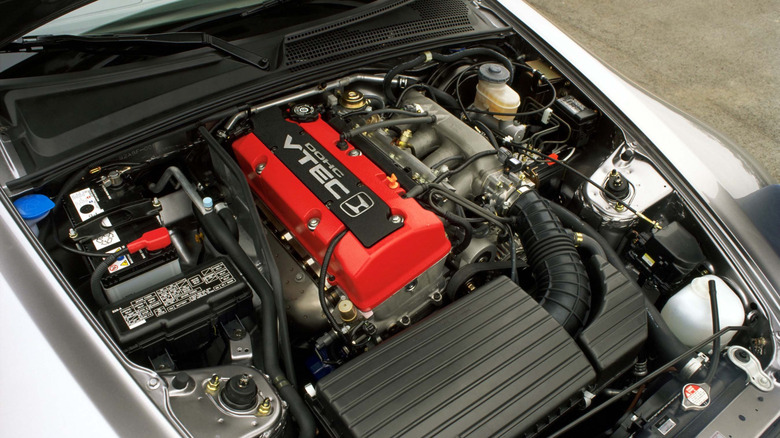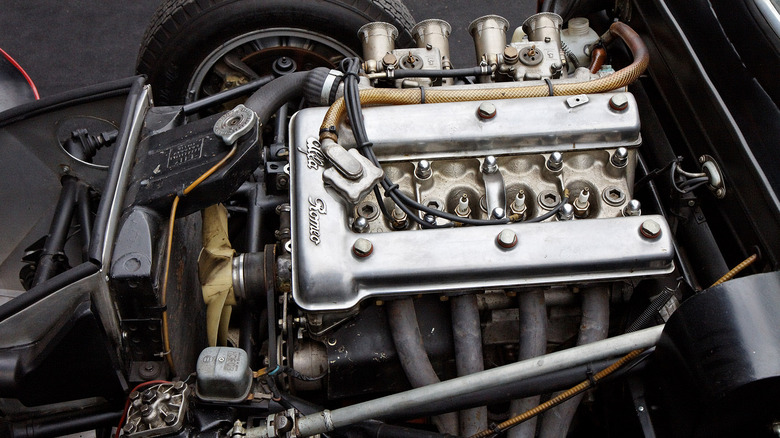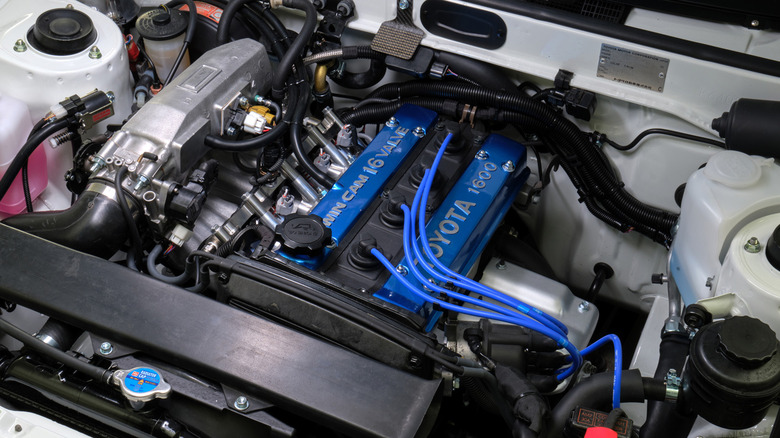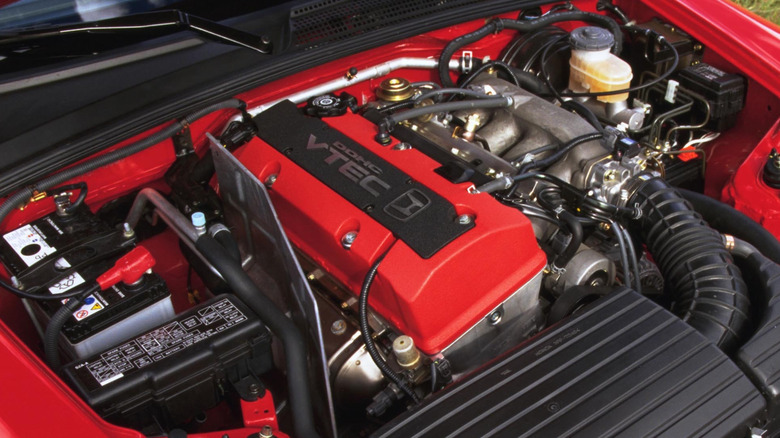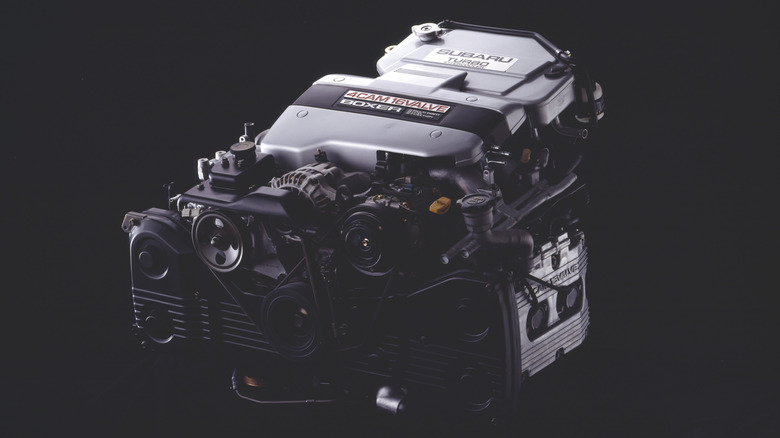5 Of The Best-Sounding Four-Cylinder Engines Of All Time
Engine sound is a highly debated topic. Some prefer the V8 rumble of American muscle cars. Others swear by high revving V10 and V12 engines. Turbo fans love their whooshing noises, regardless of the engine configuration. However, few mention four-cylinder engines when discussing aural satisfaction. And let us tell you right away: that's incorrect.
See, four-cylinder engines are quite amazing. First developed in 1894 by French automaker Panhard et Levassor, four-cylinder engines have become the de-facto standard in the industry. They are cost-effective, simple, compact, and fuel-efficient — advantages that make them the best solution for most people. Yes, they aren't as smooth as engines with higher cylinder counts. Still, we'll counter that argument with boxer-four engines, which are more balanced than inline-4s.
Now, there is some validity to the "four-cylinder engines don't sound as good as V8s" argument. After all, the more cylinders you have, the more sound frequencies are produced. In other words, the sound from high-cylinder-count engines is more complex. However, we also have ears and have heard four-cylinder engines that are an acoustic treasure trove. In this piece, we'll narrow our list of the best-sounding four-cylinder engines to five, making sure we included both inline-4 and boxer configurations. Prepare your headphones and enjoy!
Alfa Romeo Bialbero Twin Cam (1954-1997)
Alfa Romeo mastered the inline-4 with the Bialbero Twin Cam. In an era when other automakers chased ever-higher cylinder counts, the legendary Italian brand was producing fun-to-drive machines using only four. But these were not your ordinary inline-4s. Twin Cams sounded angry and throaty, but with complexity and richness to the sound. It's the total opposite of the flat noise modern four-cylinder engines make.
However, there are many other fascinating things to know about the Alfa Romeo Twin Cam engine. "Twin Cam" means "two overhead camshafts," and it was a novelty feature when the first version launched in 1954. The engine also had an aluminum block with cast iron cylinder liners for lightness and durability. Hemispherical combustion chambers. Oh, and it produced up to 100 hp, an impressive figure for a 1.3-liter engine. But, we guess it's hardly surprising for an engine designed by legendary Alfa Romeo engineer Giuseppe Busso.
Still, Alfa Romeo also bumped up the capacity over the years. 1.6-liter, 1.75-liter, and 2.0-liter versions followed with up to 130 hp. Then, in 1979, the company introduced its first turbocharged engine in the GTV Turbodelta homologation special, which produced 150 hp. One year later, Alfa Romeo outdid itself again, launching the first production car with variable valve timing, the Alfa Rome Spider 2000, again powered by a Twin Cam engine. Finally, in 1987, Twin Spark, or two spark plugs per cylinder, entered the Twin Cam arena for some impressive performance gains.
Toyota 4A-GE (1983-2002)
Toyota also has a Twin Cam it can be proud of: the mythical 4A-GE. Although it has a tiny 1.6-liter capacity, the high-revving 4A-GE sounds big. Even in stock form, it sounds like Toyota stole it from a hill-climb race car. It has that refined, aggressive sound that builds up perfectly as the revs climb up. Still, simple upgrades, like ITBs, turn the dial to 11, giving the 4A-GE sound an even sharper, raspier edge.
The 4A-GE is one of the early 16-valve four-cylinder engines with DOHC (Dual Overhead Camshaft), and the first version even had TVIS (Toyota Variable Intake System) for better responsiveness. Later, Toyota upgraded the 4A-GE to a 20-valve design, or five valves per cylinder. All 4A-GE motors also have a forged crankshaft and stout cast-iron alloy block, making it one of the most reliable small inline-4s. It also made great power; early version started with 115 hp, but the latest 20-valve Blacktop version produced an astonishing 163 hp and 8,250-rpm rev limit!
Still, you can extract much more power from this tiny engine. Even without forced induction, 200 hp at the wheels can be easily achieved. Toyota also produced a supercharged version, called the 4A-GZE, which is easier to tune and made 167 hp from the factory. The 4A-GE family also enjoys outstanding aftermarket support, so finding tuning parts is easy-peasy. Moreover, the 16-valve 4A-GE powered RWD and FWD Toyota models, making it one of the best JDM engines for any project car.
Honda F20C (2000-2009)
Honda has built some of the highest-revving engines in the industry, particularly among non-supercar brands. Perhaps the most special of the bunch is the F20C — the naturally aspirated gem that powered the S2000 roadster. This 2.0-liter had a 9,150-rpm fuel cutoff and produced a whopping 247 hp in Japan. Do the math, and you get 123.5 hp per liter.
This state-of-the-art engine has an aluminum block for lightness, but also forged crankshaft, forged aluminum pistons, molybdenum disulfide-coated piston skirts, and fiber-reinforced cylinder liners for durability. For better breathing at higher rpm, Honda kept a narrow 25.5-degree angle for all valves, and 4-3-2 exhaust manifold. Oh, and the JDM version also had an incredibly high 11.7:1 compression ratio.
Still, the star of the show was the VTEC system, which lifted the valves at 5,850 rpm for racecar-like cam setup. Once this happened, the S2000 not only surged forward with ferocity, but treated your ears to four-cylinder aural bonanza up to the 9,000-rpm redline. The refined, racecar-like sound of this engine is truly something else.
The best part — you get to enjoy it in the S2000 — one of the best driver's cars ever made. A lightweight, rear-wheel-drive roadster, the S2000 does all the basics right. It's sharp and balanced in the corners, but also quick in a straight line, sprinting to 60 mph in 5.9 seconds. Add to that one of the best stick shifts around, and you have one of the most engaging automobiles ever made.
BMW S14 (1986-1991)
Historically, BMW is mainly associated with the inline-6 engine. Even today, BMW M performance cars like the M2, M3, and M4 all come equipped with 3.0-liter turbocharged inline-6s that not only produce dizzying horsepower figures — up to 543 hp in the M4 CSL — but also sound like a dream.
However, BMW also built good four-cylinders, but they never reached the notoriety of its inline-6s and V8s. Enter: the S14 — one of BMW's best engines ever made. Yup, it's a relatively small inline-4. And no, it doesn't have a turbocharger. Yet, it produces an exhilarating noise that will excite even the most hardcore inline-6 fanatics. It's angry — ferocious even — but also very refined and harmonic. It's the type of engine you'd want to rev to the redline repeatedly just to please your sense of hearing.
The fact that this four-cylinder powered the first-ever M3 E30 only adds to the S14's appeal. Still, there have been many versions of the S14. Italy and Portugal, for instance, received the S14B20 — a 2.0-liter unit, good for 189 hp. Most other markets got the S14B23 which had a 2.3-liter capacity and up to 217 hp in the EVO2 configuration.
Still, the final iteration is the most impressive. The S14B25 EVO3 had a displacement of 2.5 liters and produced a whopping 238 hp at relatively high 7,000 rpm and 177 lb-ft of torque at 4,750 rpm. As a result, it propelled the lightweight M3 Sport Evolution homologation special to 60 in just 6.1 seconds, with a top speed of 154 mph.
Subaru EJ20 (1989-2019)
Creating an ear-candy four-cylinder is not all about natural aspiration and high revolutions. No engine illustrates that better than Subaru's EJ20 turbocharged boxer brute. This engine has one of the most recognizable sounds in the industry, better known as the "Subie rumble." It sounds almost like a V8, with a pronounced rumble that builds up nicely as the revs climb up. The boxer configuration certainly helped with this, but it's the unequal-length headers that change the harmonics and add sonic complexity.
Apart from the satisfying noise, the EJ20 is also famous for powering various Subaru WRX models over the years. Yes, that would make it a performance engine, although it was also available in naturally aspirated form for Subaru's economy cars. Still, each EJ20 has forged pistons, thick sleeves and sodium-filled exhaust valves, which allowed some crazy power figures in the turbocharged versions.
Which brings us to the JDM-only WRX STI S208 — one of the best WRXs ever made. Here, the EJ20 engine was tuned to 325 hp and had exotic add-ons, like water spray for the intercooler. Power went to all four wheels via a six-speed manual, but there was also active torque vectoring for better handling. Driving involvement was also increased with a hy 11-to-1 steering rack and adjustable Bilstein suspension. Unfortunately, this generation WRX STI was the last model with an EJ20, which has been discontinued alongside the less-reliable EJ25 in 2019.
